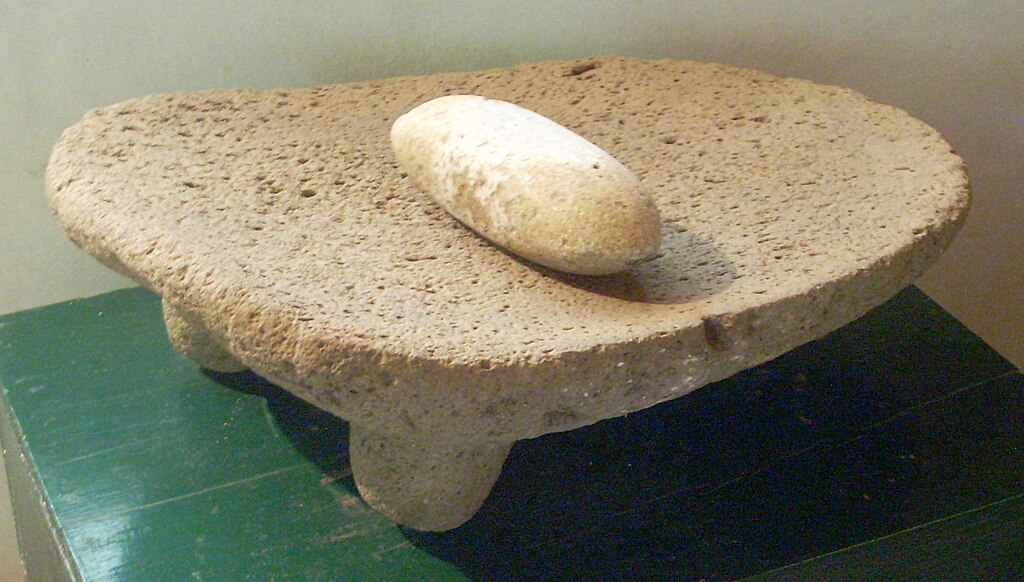In 1544, Kekchi Maya nobles traveled to Spain and presented Prince Philip with a variety of gifts from Mesoamerica (Coe, 1996). Among these gifts were quetzal feathers, chillis, maize, and chocolate. Scholars believe this interaction between Kekchi and Spanish nobility is the first example of chocolate in Europe (Coe, 1996). Following this exchange, Spain began importing cacao from Mesoamerica. By 1600, the Spanish royal court was regularly consuming chocolate in the form of a hot beverage (Coe, 1996). The introduction of chocolate to Europe spurred the development of a unique, European culture of chocolate production and consumption. This culture included the invention of special materials used to consume chocolate, including the Spanish mancerina (Coe, 1996).
A mancerina is a small plate with a raised ring in the center. The raised ring holds a small chocolate-filled cup in place and prevents it from sliding off of the plate (Moore, 2003). The mancerina was developed to prevent Spanish nobles from spilling chocolate beverages on themselves. In the 17th century, chocolate in Spain was associated with royalty and indulgence. Wealthy, high-ranking members of society consumed the exotic and decadent drink at parties, often while dancing (Coe, 1996). The mancerina thus allowed people to consume their beverage while they danced, without fear of spilling it. The mancerina, therefore, was integral to the culture of chocolate consumption in Spain, marked by nobility and excess.
Although the mancerina is a symbol of 17th-century Spanish chocolate consumption, it was not invented in Spain. Rather, it was invented by Don Pedro Alvarez de Toledo, the Marquis of Mancera, in Peru (Coe, 1996). Don Alvarez was serving as the Spanish Viceroy of Peru when he witnessed a woman at a royal gathering spill chocolate on herself (Coe, 1996). As a result, he commissioned a silversmith in Lima to craft a saucer with a raised center capable of balancing a cup to prevent spills: the mancerina (Coe, 1996). The mancerina was eventually brought to Europe and crafted using porcelain instead of silver (Coe, 1996).
Likewise, despite the mancerina’s association with Spanish nobility and chocolate consumption, the cup that the mancerina holds, called a jicara, is modeled off of pre-Columbian drinking vessels (Moore, 2003). The design of the jicara is based off of bowl-like cups made of gourds used in Mesoamerica before the Spanish arrival (Moore, 2003). As such, the mancerina, central to Spanish chocolate consumption culture, was heavily influenced by pre-Columbian Mesoamerican traditions and inventions.
The invention of the mancerina reinforced chocolate’s association with royalty and indulgence in Spain. Not only was the mancerina used to serve chocolate, a beverage that was considered exotic and luxurious, but the mancerina itself was made of porcelain, another exotic and luxurious material. Additionally, it was invented in order to facilitate the consumption of chocolate at royal parties. “The mancerina lent a certain protocol to the act of taking chocolate and heightened the status of those who could afford the product and all of its accoutrements” (Forrest and Najjaj, 2007). In addition to symbolizing the lavishness of chocolate, the mancerina was itself a lavish item that contributed to the indulgent culture of chocolate consumption in 17th-century Spain.
Furthermore, the invention of materials like the mancerina contributed to the Europeanization of chocolate and the development of a culture of chocolate consumption marked by wealth, indulgence, and colonial power. The mancerina was created to accommodate a mode of chocolate consumption that Europeans considered unique from and superior to chocolate consumption in Mesoamerica (Forrest and Najjaj, 2007). In order to remake chocolate in their own image, Europeans forwent the chillis and maize that indigenous people often added to their chocolate beverages, and instead added sugar, bread, and other materials they considered their own. In the same way, Europeans developed their own drinking vessels, like the mancerina, in order to enjoy chocolate in a uniquely European way. The appropriation of chocolate and modes of chocolate consumption in Europe represented feelings of “nationalism and cultural superiority” (Forrest and Najjaj, 2007). The mancerina served to reinforce the notion that chocolate belonged to Europe. In addition to the invention of new chocolate beverage recipes, the development of materials like the mancerina, designed specifically for chocolate consumption in Europe, contributed to the appropriation of chocolate and the development of a European culture of chocolate consumption denoted by wealth, indulgence, and colonial power.
Following the introduction of chocolate to Europe by Kekchi Maya nobles in 1544, a culture of chocolate consumption developed in Spain. Chocolate came to be identified with royalty, decadence, and power. Central to the development of this culture was the invention of materials designed to accommodate modes of chocolate consumption specific to royal European society. One such material was the mancerina, a porcelain saucer designed to securely balance a chocolate-filled cup, which exemplified and contributed to the lavish culture surrounding chocolate in 17th-century Spain.

A drawing of 17th-century Spanish nobles sipping chocolate from mancerinas (Coe, 1996).

A porcelain mancerina, crafted sometime between 1735 and 1760 (Torrecid).

A porcelain mancerina, crafted sometime between 1770 and 1798, designed to look like a dove (Torrecid).
WORKS CITED:
“Ceramic Art Collection.” Torrecid, http://www.torrecid.com/museum/index.php/ceramic-art-collection/.
Coe, Sophie D, and Michael D. Coe. The True History of Chocolate. New York: Thames and Hudson, 1996.
Forrest, Beth Marie, and April L Najjaj. “Is Sipping Sin Breaking Fast? The Catholic Chocolate Controversy and the Changing World of Early Modern Spain.” Food and Foodways: Chocolate: Case Studies in History and Culture, vol. 15, no. 1-2, 2007, pp. 31–52.
Moore, Janet H. “Culture and Thought—Arts: Peking on the Rio Grande—An Art Form that Mixes Cranes, Cacti and Cultures.” Asian Wall Street Journal, Feb 07, 2003, ProQuest, http://search.proquest.com.ezp-prod1.hul.harvard.edu/docview/315498543?accountid=11311.




















You must be logged in to post a comment.